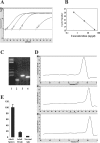Developmental specificity of recruitment of TBP to the TATA box of the human gamma-globin gene
- PMID: 11960008
- PMCID: PMC122800
- DOI: 10.1073/pnas.072084499
Developmental specificity of recruitment of TBP to the TATA box of the human gamma-globin gene
Abstract
It is unclear whether the core promoter is involved in developmental regulation. To address this question, we mutated the TATA box of the human gamma-globin gene, produced transgenic mice, and examined the effect of the mutation during the course of mouse development. In our test system, the gamma-globin gene is expressed at similar levels in the embryonic and adult erythroid cells. The TATA box mutation dramatically reduced expression of the gamma-globin gene in the adult but not in embryonic erythroid cells. In addition, the disruption of the gamma TATA box significantly reduced the recruitment of TATA box-binding protein (TBP) in the adult cells, but not in embryonic cells, suggesting that the recruitment of TBP to the gamma gene promoter is developmentally specific. Similarly, the recruitment of transcription factor II B and RNA polymerase II to the gamma promoter was affected in the adult but not in embryonic cells. The distinct effects of the TATA mutation in the embryonic and adult developmental stages suggest that the basal transcription apparatus can be recruited to a core promoter in a developmental stage-dependent manner. The TATA mutation resulted in a shift of transcription initiation site 6 bp or longer upstream to the cap site both in the embryonic and adult erythrocytes. We conclude that the TATA box determines the initiation site but not the efficiency of transcription of the gamma-globin gene.
Figures




Similar articles
-
A major role for the TATA box in recruitment of chromatin modifying complexes to a globin gene promoter.Proc Natl Acad Sci U S A. 2003 Jun 10;100(12):7009-14. doi: 10.1073/pnas.1236499100. Epub 2003 May 28. Proc Natl Acad Sci U S A. 2003. PMID: 12773626 Free PMC article.
-
DNA-protein interactions in the proximal zeta-globin promoter: identification of novel CCACCC- and CCAAT-binding proteins.Blood Cells Mol Dis. 1998 Jun;24(2):183-98. doi: 10.1006/bcmd.1998.0185. Blood Cells Mol Dis. 1998. PMID: 9642099
-
Evidence for functional interaction between the HIV-1 Tat transactivator and the TATA box binding protein in vivo.J Mol Biol. 1995 Jul 7;250(2):169-80. doi: 10.1006/jmbi.1995.0368. J Mol Biol. 1995. PMID: 7608968
-
Role of intergenic human gamma-delta-globin sequences in human hemoglobin switching and reactivation of fetal hemoglobin in adult erythroid cells.Ann N Y Acad Sci. 2005;1054:48-54. doi: 10.1196/annals.1345.057. Ann N Y Acad Sci. 2005. PMID: 16339651 Review.
-
[TATA box polymorphisms in genes of commercial and laboratory animals and plants associated with selectively valuable traits].Genetika. 2010 Apr;46(4):448-57. Genetika. 2010. PMID: 20536014 Review. Russian.
Cited by
-
A naturally occurring polymorphism at Drosophila melanogaster Lim3 Locus, a homolog of human LHX3/4, affects Lim3 transcription and fly lifespan.PLoS One. 2010 Sep 7;5(9):e12621. doi: 10.1371/journal.pone.0012621. PLoS One. 2010. PMID: 20838645 Free PMC article.
-
The minimal promoter plays a major role in silencing of the galago gamma-globin gene in adult erythropoiesis.Proc Natl Acad Sci U S A. 2004 May 25;101(21):8096-101. doi: 10.1073/pnas.0402594101. Epub 2004 May 17. Proc Natl Acad Sci U S A. 2004. PMID: 15148375 Free PMC article.
-
Genomic environments scale the activities of diverse core promoters.Genome Res. 2022 Jan;32(1):85-96. doi: 10.1101/gr.276025.121. Epub 2021 Dec 27. Genome Res. 2022. PMID: 34961747 Free PMC article.
-
Characterization and Expression of the Lucina pectinata Oxygen and Sulfide Binding Hemoglobin Genes.PLoS One. 2016 Jan 29;11(1):e0147977. doi: 10.1371/journal.pone.0147977. eCollection 2016. PLoS One. 2016. PMID: 26824233 Free PMC article.
-
Real-time monitoring of functional interactions between upstream and core promoter sequences in living cells of sea urchin embryos.Nucleic Acids Res. 2007;35(14):4882-94. doi: 10.1093/nar/gkm519. Epub 2007 Jul 10. Nucleic Acids Res. 2007. PMID: 17626044 Free PMC article.
References
-
- Holmes M C, Tjian R. Science. 2000;288:867–870. - PubMed
-
- Kuras L, Kosa P, Mencia M, Struhl K. Science. 2000;288:1244–1248. - PubMed
-
- Li X Y, Bhaumik S R, Green M R. Science. 2000;288:1242–1244. - PubMed
-
- Dantonel J C, Quintin S, Lakatos L, Labouesse M, Tora L. Mol Cell. 2000;6:715–722. - PubMed
-
- Kaltenbach L, Horner M A, Rothman J H, Mango S E. Mol Cell. 2000;6:705–713. - PubMed
Publication types
MeSH terms
Substances
LinkOut - more resources
Full Text Sources
Molecular Biology Databases
Miscellaneous

